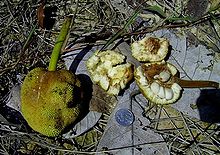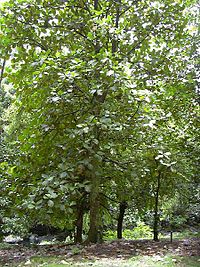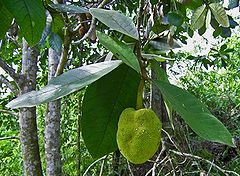- Marang
-
Marang/Tarap 
Scientific classification Kingdom: Plantae (unranked): Angiosperms (unranked): Eudicots (unranked): Rosids Order: Rosales Family: Moraceae Tribe: Artocarpeae Genus: Artocarpus Species: A. odoratissimus Binomial name Artocarpus odoratissimus
BlancoThe marang (Artocarpus odoratissimus), also called johey oak, green pedalai, madang, tarap, terap, timadang, or breadfruit cousin, is a tree native to Borneo and Palawan. It is closely related to the jackfruit, cempedak, and breadfruit trees.
It is an evergreen tree growing to 25 m tall. The leaves are 16–50 cm long and 11–28 cm broad, similar to the Breadfruit's, but are a little less lobed.
As indicated by the scientific name, the fruit has a strong scent, and is considered superior in flavour to both Jackfruit and Cempedak.
The appearance of the fruit can be regarded as an intermediate shape between the jackfruit and the breadfruit. It is round to oblong, 15–20 cm long and 13 cm broad, and weighing about 1 kg. The thick rind is covered with soft, broad spines. They become hard and brittle as the fruit matures. The fruit does not fall to the ground when ripe. It may be harvested while still hard, and left to ripen until soft. Marangs change colour to greenish yellow when ripe. The ripe fruit is opened by cutting the rind around, twisting and gently pulling. The interior of the fruit is somewhat similar to the jackfruit's, but the color is white and the flesh is usually softer. The core is relatively large, but there are far fewer "rags" and less non-edible parts. Arils are white and the size of a grape, each containing a 15 × 8 mm seed. Once opened, the marang should be consumed quickly (in a few hours), as it loses flavour rapidly and fruit oxidizes. The seeds are also edible after boiling or roasting.
The tree is not cold tolerant (as is the breadfruit). It can grow between latitude 15º north and south, and in coastal regions where temperatures never stay under 7 °C. It is cultivated for its fruit in Indonesia, Malaysia, the Philippines, and southern Thailand. The species is largely grown for local consumption; the short shelf-life of the fruit limits its wider use.
Taxonomy
The taxonomy of Artocarpus can be confusing. The species Artocarpus sericicarpus and Artocarpus sarawakensis, known as the Pedalai, or buah tarap or Pingan or Mountain tarap is very similar to, and often confused with the Marang. Both these species are native to the same areas. However, they are still distinguishable based on their appearances when ripe. The Pedalai has hairs, like a large rambutan, and ripens red. The Pingan is even trickier, because it is the shape of a Marang, and it is a orange. It has smaller kernel sections. The Marang remains greenish when ripe and has very dense, straight green protrusions.
References
Categories:
Wikimedia Foundation. 2010.


